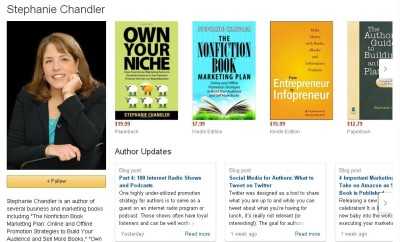Case Study: How Stephanie Chandler Creates Authority Through Self-Publishing

The Versatility of Articles In Content Marketing

3 Ways to Do E-mail Marketing Right
Stephanie Chandler has a unique story to tell among nonfiction book authors. She is a traditionally published author with nine titles under her belt who decided to publish her own books as a way to boost her authority and seek the benefits of authorship beyond profits and revenues. She publishes in print and e-book formats and considers both to be equally important. In many ways, she’s the ideal case study subject.
“I could never tell you how many copies of a book I have sold,” she says, “and I really don’t care.”
That’s because her books serve as business cards. They deliver other opportunities like speaking engagements, corporate sponsorships, and client consultations.
“That’s always been my focus.”
Chandler published three books with traditional publishing houses before starting her own publishing company in 2008, through which she now publishes her own titles, as well as her clients’ books. But, she says, it was her eighth book, “Own Your Niche: Hype-Free Internet Marketing Tactics to Establish Authority in Your Field and Promote Your Service-Based Business“, in 2012, that caused her author career to shift into overdrive.
Stephanie Chandler’s Publishing Process
 Like all good nonfiction authors, Stephanie Chandler begins with a book idea, but she gets inspiration for her ideas from asking what it is she wishes someone had told her.
Like all good nonfiction authors, Stephanie Chandler begins with a book idea, but she gets inspiration for her ideas from asking what it is she wishes someone had told her.
My goal has always been to write a book I would want to read,” she says.
Unlike a lot of independent authors, however, she outsources most of the production work to specialists. She writes the book herself, but she outsources cover design, editing, formatting, and every other part of the process.
“I care about quality,” she says. “I spent years finding the right people and I’m loyal to the people who work for me.” In the end, she spends $3,000 to $4,000 on the publishing process from front to finish. And that’s just the manufacturing process. “I have good people, so I pay them well.”
Instead of publishing her e-books at each of the online bookstores where e-books are sold, she distributes her books through Smashwords. The only exception is the Kindle format. For that, she goes directly to Amazon.
“I don’t see a reason to (publish directly with Barnes & Noble, Kobo, etc.) when Smashwords makes it so easy for me,” she says.
Marketing Begins in the Pre-Launch Phase
I don’t aim to do a one-day BS campaign. That has no long-term value.
“In the pre-launch phase, I get all my copy written, put my e-mails together, and pre-write all my blog posts. I have a spreadsheet with target dates on it for when each piece will publish, and I pre-schedule them to publish on the target date,” she says. The entire process can take as long as three months.
Another marketing tactic she employs to encourage early sales is to sponsor a bonus package giveaway.
“On my last book, ‘The Nonfiction Book Marketing Plan‘, I bundled a number of information products of mine for people who purchased the book,” she says. “And it wasn’t for just one day. I don’t aim to do a one-day BS campaign. That has no long-term value.”
Instead, she promotes her bundled bonus package for 30 days and asks her early readers to leave reviews at Amazon and Smashwords.
“I do not fear my book getting stolen,” she says. “If someone is going to pass around a PDF copy of my book, I don’t care. I’ll gain new readers and fans. They’re going to look for my other books and sign up for my services. So send it to everyone you know.”
While she does use e-mail to drive traffic to the promotion page on her website, she admits that she is low-key about it.
“I don’t want to be obnoxious,” she says. “So I leverage social media. I rely heavily on Facebook, Twitter, and LinkedIn.” Her e-mail blasts are weekly rather than daily and only to her warmest fans. “E-marketing is an ongoing effort. I see the results based on the effort I put into it. When I promote, sales go up.”
When she launched “The Nonfiction Book Marketing Plan”, Amazon’s and Smashwords’ pre-sales tools weren’t available, but Chandler says she’ll use those tools for future book launches. She says she’ll likely pre-sell her books for 90 days.
“Any amount of time you can get the buzz started is a good thing,” she says.
Launch Day: How Chandler Manages Time
 Of course, marketing is not over when her books launch. After preparing all her marketing material in advance, launch day is filled with ensuring everything goes without a hitch. Her social media posts are made, blog posts are published, e-mails are sent out, and future marketing efforts are planned and scheduled, as well.
Of course, marketing is not over when her books launch. After preparing all her marketing material in advance, launch day is filled with ensuring everything goes without a hitch. Her social media posts are made, blog posts are published, e-mails are sent out, and future marketing efforts are planned and scheduled, as well.
“I’m a huge time management junkie,” she says. “I block out a couple of full afternoons to make sure I get it done.”
To ensure her content is high quality, she writes it on the first day and lets it sit a couple of days. Then she looks at it with a fresh set of eyes for the editing and revision process. To her warm list of fans, she e-mails a list of pre-written tweets and Facebook posts they can use if they want to help her promote her book.
“You want to try to make it easy for people,” she says. Her warm list includes fellow authors, people she meets at conferences, and other speakers—people she knows are truly fans and readers. While she hasn’t used beta readers in the past, she does think it’s a good strategy for getting more book reviews. “Give your book away, for goodness sake. The more people who read your book, the more people will tell their friends.”
Chandler’s 3 Essential Marketing Tactics
 At the end of the day, it’s not about sales. It’s about how many people read her books.
At the end of the day, it’s not about sales. It’s about how many people read her books.
Another strategy Chandler shuns like the plague is KDP Select. She is leery of limited distribution strategies and exclusivity deals.
“A couple of years ago,” she says, “I thought I’d host my own e-book giveaway. ‘Own Your Niche’ had been out for a year. I gave it away for free on my website. My goal was to get 300 downloads in three days. Dang if I didn’t get 1,000 downloads.” And all she did was send out some tweets, a few Facebook posts, and a notice to her mailing list. “I’d do that again in a heartbeat.”
Chandler sees a new e-mail address for her list the biggest benefit an author can have. After all, a free download on Amazon doesn’t net anything. You don’t know who is downloading your book, and you can’t market future books to them or let them know about your other services if you rely solely on Amazon.
But she doesn’t rely solely on free promotion either.
“I’m a big fan of Facebook ads,” she says. “I use the pay-to-play model.”
To get reviews, she likes services like Net Galley, which charges to have her books downloaded for reader review. Another tactic she uses is to search Amazon for competing book titles and asking people who reviewed those books to review hers.
“A lot of book reviewers maintain their own blogs,” she says. “They’re writing their own books. That’s the most effective way to get book reviews.” To find those reviewers, she uses a software called Book Review Targeter. “Book reviews have a big impact on book sales.”
If you look at her books on Amazon, you’ll see her titles have lots of reviews. You’ll also see her e-books priced in the $7.99 range, a bit higher than most indie authors’ books. That’s because nonfiction readers aren’t as price sensitive as fiction readers. They’re not reading based on price but on the value of the information. Chandler believes pricing her books higher actually results in more sales.
“I’ll drop the price to $4.99, and I don’t see any difference when I do that,” she says.
In a nutshell,
- Give your e-book away for free
- Pay for ads
- And price your e-books optimally
 Are you ready to boost your authority? Looking for ways to expand your reach and deliver the best content for your niche audience? Download my free report, “14 Types of Authority Content“. Learn the 14 types of content that will keep your audience coming back for more and instantly make you an authority they can rely on.
Are you ready to boost your authority? Looking for ways to expand your reach and deliver the best content for your niche audience? Download my free report, “14 Types of Authority Content“. Learn the 14 types of content that will keep your audience coming back for more and instantly make you an authority they can rely on.
* Trust me, I’m no fan of spam either. You can trust me with your contact information. I’ll use it only to deliver your special report, and occasionally may send out special offers or communicate with you on building authority with content. You can opt out any time.
Buy Stephanie Chandler’s Books at Amazon
Note: Not all of these are available in the Kindle format.

- The Business Startup Checklist and Planning Guide
(2005)
- From Entrepreneur to Infopreneur
(2007)
- The Author’s Guide to Building an Online Platform
(2008)
- Leap! 101 Ways to Grow Your Business
(2009)
- How to Start and Run a Used Book Store
(2010)
- Booked Up! How to Write, Publish, and Promote a Book to Grow Your Business
(2010)
- The Conference Catcher
(2011)
- Own Your Niche: Hype-Free Internet Marketing Tactics to Establish Authority in Your Field and Promote Your Service-Based Business (2012)
- The Nonfiction Book Marketing Plan (2013)


